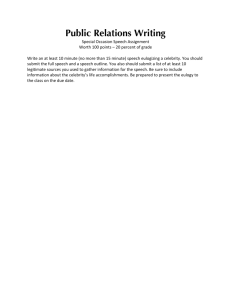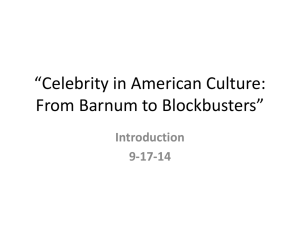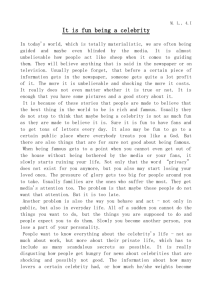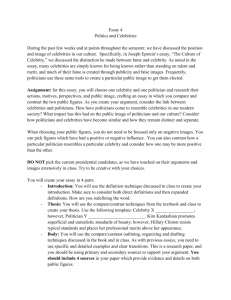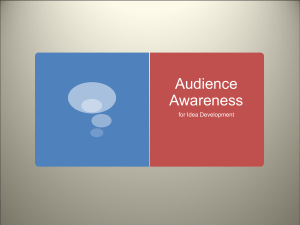The Sociology of Celebrity
advertisement
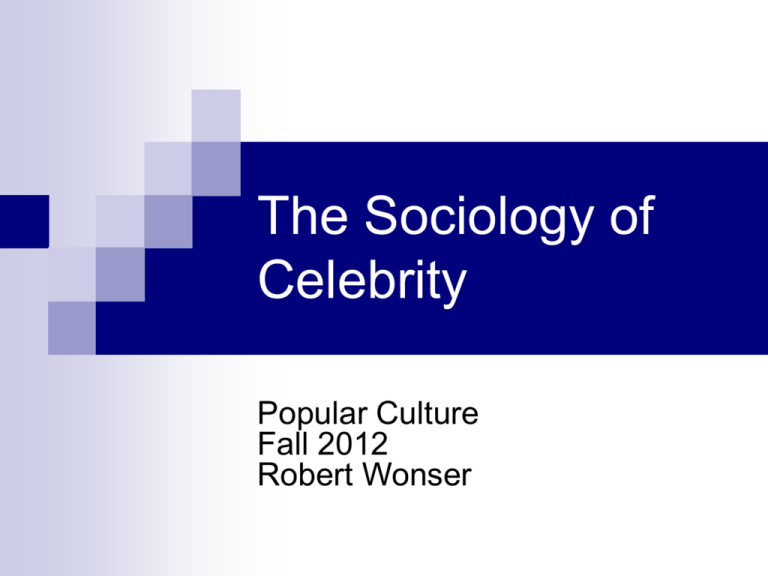
The Sociology of Celebrity Popular Culture Fall 2012 Robert Wonser What are Celebrities? Celebrity is the site of a surplus of contemporary society’s charisma—by its very nature it involves individuals with special qualities Mills: celebrity is the “American form of public honor” Celebrity and its Public Scant social science attention except as “celebrity as pathology” Celebrities aren’t necessarily more talented, skilled, intelligent etc., just better packaged, promoted and thrust upon hungry gullible masses Celebrity is dangerous and fans and the rest of society is damaged by their contact with it Celebrities are narcissists Fans’ “celebrity worship” linked with negative traits: dependency, “game-playing” in romantic relationships, shyness, loneliness, authoritarianism Celebrity as Commodity In line with critical theory approach; (Horkheimer and Adorno), when citizens give themselves up to the easy pleasures of capitalism (like mass media, consumerism, celebrity) they are more readily controlled by tyrants. Fans and consumers havce been duped by capitalism into fancying something worthless and unhealthy Pacify and squelch dissent inducing somatic complacency Celebrity as Commodity Celebrity as replacement god Opiate of the masses Carrier of ideology Consumption of Celebrities We consume them; celebrities both sell and are sold What happens to celebrities (their commodification) is just more explicit of what capitalism does to all of us; turns us into things to be bought and sold Celebrities embody 2 dominant Western ideologies: individualism and market capitalism They serve as signs through which these ideologies get passed onto the population Celebrity: Interactional Approach Microstructuralism approach: Cultural norms are built into the context of each interactional situation and the actors’ behavior either conforms to or deviates from these norms. “negotiated order” perspective: norms are not necessarily fixed but are often negotiated interactionally as situations emerge and develop Regular Guy Pretends to be a Celebrity in Times Square Fans and Celebrity “illusion of intimacy” One-sided; imbalance of power Asymmetrical What about Twitter and FB? Celebrities as “intimate strangers” Celebrities = strangers Friends, family, colleagues = intimates The Moral Order of Celebrity Sightings Celebrity sighting provide insight into the everyday rules of interaction that govern mundane encounters Status differentials when normal people rub elbows with the famous Presence of a celebrity represents a “situational impropriety” something is out of place in a situation (Goffman 1963) “We’re not worthy! We’re not worthy!” The Moral Order of Celebrity Sightings Etiquette of these encounters based on “civil inattention” which involves looking at someone and then quickly looking away as you approach them on the street, but not giving them any further attention or acknowledging them in any way When we approach someone we know we engage in “Deference rituals” in which the approached person’s status is acknowledged overtly through the greetings and gestures of the approaching person (1967:72) Rituals serve to preserve the status of those deferred to, and their violation threatens it So… which interaction rules should be used? Moral Orders Moral order is a shared set of values and norms, prescriptions and proscriptions, punishments and rewards that create and maintain social cohesion, community and solidarity. Functions of the moral order: facilitates social cohesion, provides a form of social control, offers a set of rules of behavior for which persons are held accountable, and furnishes guidelines for managing conflicts when they arise Are celebrities intimates or strangers? Does how we proceed depend on the answer to this question? Interpretive work of Celebrity Encounters Two types: Recognition work: When seers struggle to define and comprehend the presence of a celebrity in their ordinary world Response work: When seers present themselves to the celebrity, engineering the encounter to create a particular definition of the situation Interpretive Work: Recognition work Recognition work – recognition of a celebrity is not automatic and the process of recognition is problematic specifically because the presence of the extraordinary challenges routine assumptions about ordinary experience Double take – recognition may begin with a sense of familiarity (somehow recognizable) Great expectations – celebrities don’t always look the way we expect them to look (eg: shorter in person) Proof positive – after recognition is made we seek some evidence to authenticate that who we are seeing is really who we think it is (eg: that knowing smirk…) Interpretive Work: Response work Response work - attending to the presentation of our ordinary self in the presence of the extra ordinary star Staying cool – can take the form of playing it cool… (easiest course of action to take) Preserving the celebrity's privacy is part of the moral order, but so is avoiding your own embarrassment by sticking to the situational rules Your biggest fan – the recognition of a celebrity and the gushing over them exposes you and the celebrity to potential embarrassment, so mitigate it with accounts of excuses (“biggest fan, I had to!”) Two thumbs down – when celebrities encounter non-celebrities in public, they themselves are expected to do their part in upholding the moral order of the situation What do we expect of celebrities in public? Too flashy? Boo… Conclusion “minor ceremonies” (Goffman 1967:91) of celebrity sightings underscore and reproduce the contemporary secular moral orders of status, fame and reputation in everyday life. Special kind of encounter with its own rules for interaction Emergent rules of celebrity sightings uphold and police various boundaries: ordinary versus extraordinary, obscurity versus fame, stranger versus intimate.
